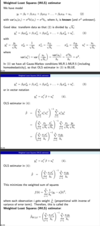Week 4 Flashcards
(21 cards)
What is heteroskedasticity?
The variance does not remain constant over the regression. Can be denoted as:

Derive that the OLS estimator is still unbiased in the case of hetroskedacity.

Derive the variance-covariance matrix of the OLS estimator in case of hetroskedacity.

Derive that the OLS estimator is still consistant in case of heteroskedasticity.

How are the White heteroskedasticity-robust standard errors computed?

How is the variance-matrix estimated if we make the additional assumption of normality u|X ~ N(0, Ω)

If we assume normality what is the impact on the distribution of βhat

Why is the OLS model no longer BLUE in case of heteroskedasticity?
The 5’th assumption does not hold.
How can we test for heteroskedasticity?
We can use the Breusch-Pagan test.
What are the steps for the Breusch-Pagan test?

What are the variables you choose in a Breusch-Pagan test when you are using the White test (with and without crossterms).

What is the WLS estimator?
If you have a DGP where you know how the variance changes based on the xi (now denoted as h(xi)), then you can transform the data such that this variance remains stable.
You then get yi* = yi / sqrt(h(xi)), xi0* = 1 / sqrt(h(xi)), xi1* = xi1 / sqrt(h(xi)), …, ui* = ui / sqrt(h(xi)). Then you have that the Var(ui*) = Var(ui) / h(xi) = σ2 (thus homoskedasticity).
Show that the WLS estimator is the OLS estimator in a linear regression model (for transformed
data) that satisfies the Gauss-Markov assumptions.



In case of heteroskedasticity, in what sense is the WLS better than the OLS?

What are the steps of FWLS?

When is the FWSL used?
When we can not find appropriate specification Var(ui|xi) ~ σ2hi with known hi.
What are the steps used for the Iterated FWLS?

In what sense is the FWLS estimator better than the OLS estimator in case of (correctly specified) heteroskedasticity?

What are the properties of the FWLS estimator?
- asymptotically FWLS estimator has properties of WLS estimator

For a large sample size n: What can we conclude from a large difference in the White heteroskedasticity-robust standard errors between the OLS and (F)WLS estimators? What can we conclude from a large difference between the OLS and (F)WLS estimators?
Huge differences between OLS and (F)WLS estimators suggest non-linear relationship.


